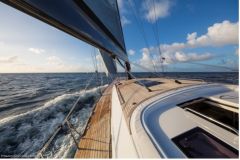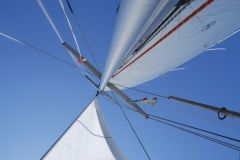The rigging is an essential part of your sailboat. It is subjected to wind, vibrations and shocks. Over time, each part wears out. To avoid chain damage, make sure you check it regularly to ensure your safety and best performance at sea.

Know your rig
The rig includes :
- the mast, with its spreaders and aluminium or composite parts,
- standing rigging: shrouds, forestay, backstay, chainplates and terminations,
- running rigging: halyards, sheets, blocks, blocks and other moving parts.
Each of these elements can be damaged by corrosion, material fatigue, mechanical stress or loosening.

Signs of wear
Look out for any visible changes: dents or cracks on the mast, corrosion at contact points, broken wires on a rope, seized turnbuckles, damaged ropes or worn pulleys.
A mast that is no longer straight may also indicate a tension problem. Last but not least, unusual noises or vibrations while sailing should always raise a red flag.

When and how to overhaul your rig?
The right time for an overhaul is at the end or beginning of the season, after wintering, but also after intensive use or a gale.
Ideally, remove or relieve the mast to gain access to all areas. Start with a thorough cleaning, then carefully inspect crimps, chainplates and terminations. Check shroud, forestay and backstay tension, and compare with recommended settings.
If in doubt about a part, replace it immediately. When reassembling, grease the threads and maintain the blocks and blocks. Finish with a sea trial: the rig must remain stable and well tensioned.

When should you call in a professional?
Some operations require the help of a rigger. This is the case for composite masts, replacement of cable terminations or repairs after an impact. A professional has the experience and tools to detect invisible weaknesses and ensure a lasting repair. It's an investment that avoids much more costly breakages.

The benefits of a well-maintained rig
A rig in good condition means greater safety and peace of mind. Your boat is more stable, your sails hold better in the wind and vibrations are reduced. By regularly maintaining your mast, you can avoid unforeseen expenses and preserve the value of your yacht.

 /
/ 







